The Gare de l'Est, one of Paris's main railway stations, is an architectural gem and a nerve centre of the French rail network. Nestling in the 10th arrondissement, this historic station has a fascinating story to tell.
In fact, it is much more than just a transit point for passengers. It is a living witness to the history of Paris and France.
In this article, we will delve into the world of Paris-Est station, exploring its origins, architecture, importance in the rail network, and the exciting anecdotes and secrets it holds.

La gare de l'Est © French Moments
What about the Paris-Est station?
To the north of the historic centre of Paris, the Gare de l'Est is one of the six major termini of the SNCF network in Paris.
Several names apply to this railway station:
- Gare de Paris-Est,
- the Gare de l'Est,
- and, formerly, Gare de Strasbourg (its original name, which is no longer used).
Its location in the north of the city makes it an essential gateway for travellers from eastern France, Germany, Belgium, Luxembourg and beyond. It is a point of convergence, a crossroads where thousands of travellers cross paths daily.
But beyond its practical function, the Gare de l'Est is imbued with an atmosphere rich in history and fascinating anecdotes that set it apart from other Paris stations.

The Paris-Est railway station© French Moments
10 Fun Facts about Gare de l'Est
The Gare de l'Est is more than just a railway station. It is also the silent witness to many historical and cultural events.
In the second part of this article, we explore seven fascinating aspects that make this Parisian station unique.
From the Haussmannian panorama that opens up its doors to the moving historical fresco that adorns its walls to the films that have been shot there, we'll reveal all the secrets and curiosities that make the Gare de Paris-Est a must-see in the French capital.
1. A station located to the north of Paris
Curiously, Gare de l'Est is not located to the east of Paris, but rather to the north. This apparently unusual location is explained by the need to bypass the high hills of Belleville, Romainville and Fontenay-sous-Bois.
When the station was being planned, some had advocated that the railway line linking the capital to the eastern regions should start at the Gare d'Austerlitz or the Gare de Lyon, but these locations were not chosen. Gare de l'Est stands at an altitude of 46 metres in the 10th arrondissement, close to its larger neighbour, Gare du Nord.
![Gare de Paris Est et Gare de Paris Nord © David.Monniaux - licence [CC BY-SA 3.0] from Wikimedia Commons Gare de Paris Est et Gare de Paris Nord © David.Monniaux - licence [CC BY-SA 3.0] from Wikimedia Commons](https://frenchmoments.eu/wp-content/uploads/2023/09/Gare-de-Paris-Est-et-Gare-de-Paris-Nord-©-David.Monniaux-licence-CC-BY-SA-3.0-from-Wikimedia-Commons-scaled-1.jpg)
Gare de l'Est and Gare du Nord (seen from the north to the south) © David.Monniaux - licence [CC BY-SA 3.0] from Wikimedia Commons
2. At the end of a long Haussmann perspective
Its façade marks the end of the north-south perspective that was laid out under the direction of Baron Haussmann, Prefect of the Seine.
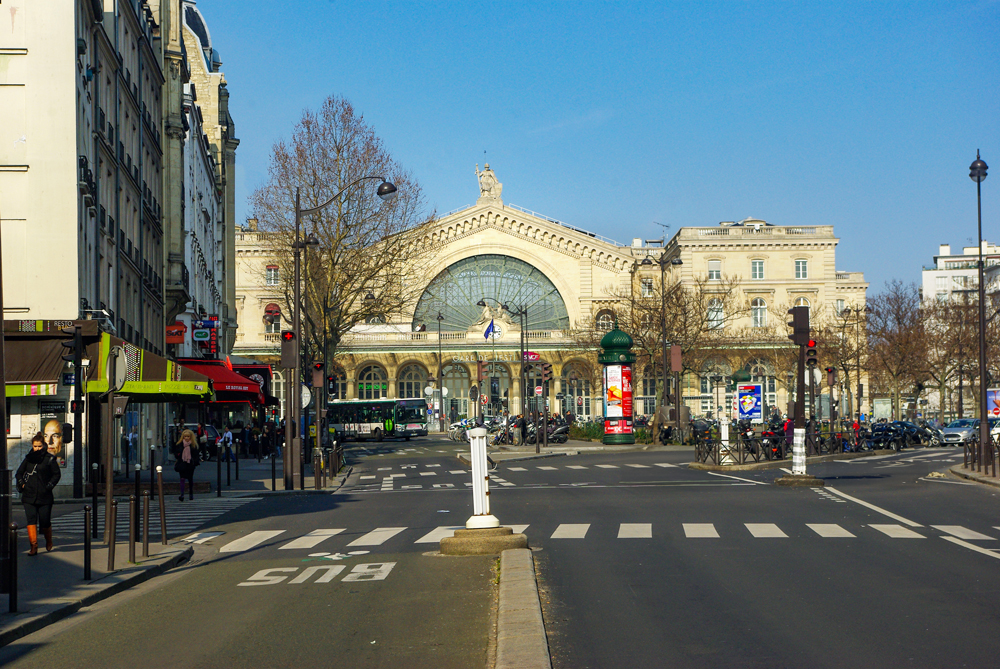
Paris-Est station at the end of Boulevard de Strasbourg © French Moments
This route, which starts at the Place du Châtelet, is made up of two boulevards: Boulevard de Sébastopol and Boulevard de Strasbourg, inaugurated in 1858 and 1853 respectively.

Boulevard de Sébastopol extended by Boulevard de Strasbourg. View of the Tour Saint-Jacques © French Moments

View of the station and its two halls from the Tour Saint-Jacques © French Moments
It is interesting to note that the neighbouring Gare du Nord does not enjoy a similar perspective. The short Boulevard de Denain ends at the intersection of Boulevard de Magenta and Rue La Fayette.
3. From the Strasbourg Pier to the East-Station
The history of Gare de l'Est began in 1849 with the opening of a pier by the Compagnie de Paris à Strasbourg, inaugurated by Napoléon III, then President of the Republic. At the time, the station essentially consisted of two tracks sheltered under a large concourse.
In 1854, the station was renamed "Gare de l'Est" following the opening of the Mulhouse line. At the same time, the company itself also changed its name to "Compagnie des chemins de fer de l'Est", a more inclusive choice reflecting its expansion into eastern France.
![Gare de Paris-Est 1850 [Public Domain via Wikimedia Commons] Gare de Paris-Est 1850 [Public Domain via Wikimedia Commons]](https://frenchmoments.eu/wp-content/uploads/2023/09/Gare-de-Paris-Est-1850-Public-Domain-via-Wikimedia-Commons.jpg)
Gare de Paris-Est circa 1850 [Public Domain via Wikimedia Commons]
Gare de l'Est has undergone several phases of expansion over the years, notably in 1885, 1900 and between 1926 and 1931. More recently, in 2007, the arrival of the TGV-Est high-speed train at Gare de l'Est led to major redevelopment work to meet the needs of modern rail transport.
An emblematic moment in its history took place on 4 October 1883, when the legendary Orient-Express line was inaugurated at Gare de l'Est. This luxury train set off for Vienna, Venice and Istanbul, becoming an icon of travel and refinement across Europe from 1919 onwards.
4. A neo-classical architecture
The façade of Gare de l'Est is a remarkable example of neo-classical architecture. Perhaps it reminds you of the elegant 18th-century buildings in Lorraine, such as the palaces of Commercy and Lunéville, or the Place Stanislas in Nancy? In fact, the Lorraine influence is obvious, particularly in the choice of ashlar used to build the station, the famous Euville stone, quarried between Toul and Commercy.
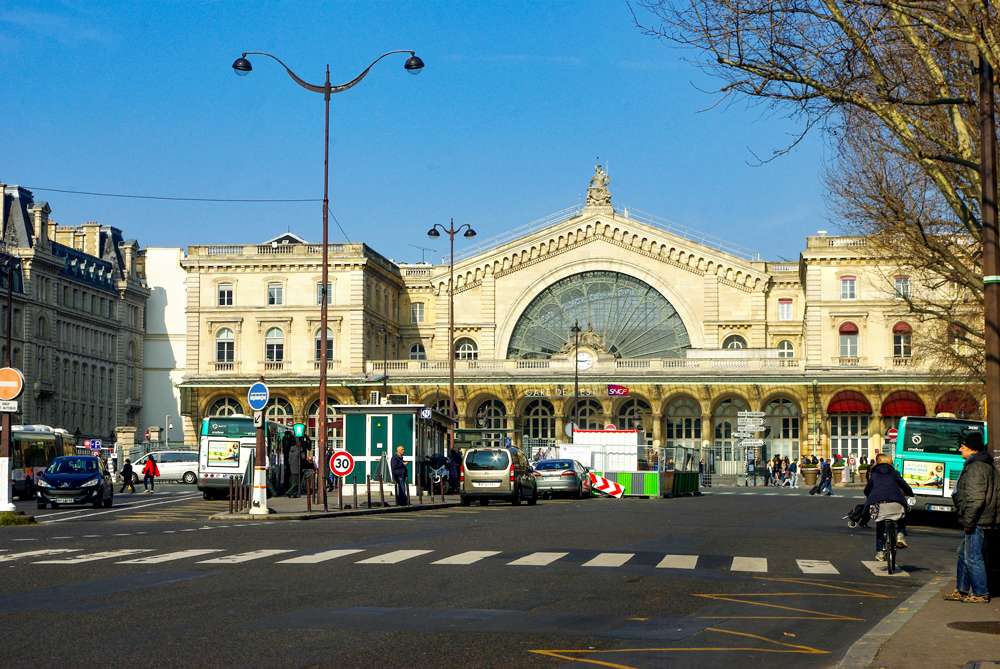
A railway station built in Euville stone © French Moments
Two wings for a grand station
The façade of Gare de l'Est consists of two almost identical sections, each with a gabled roof decorated with Lombardy strip motifs and surmounted by an allegorical statue.

The half-rose window of the Hall Alsace (1850) © French Moments
Each wing is also lit by a half-rosette and houses a clock surrounded by allegorical sculptures.

Detail of a clock framed by the Rhine and the Seine © French Moments
- The oldest wing, the west wing, dates from 1850 and features allegories of the Rhine and the Seine on either side of the clock. The gable is topped by an allegorical statue of Strasbourg sculpted by Henri Lemaire. It gives access to the Hall Alsace.
- The east wing, added in 1931 after the First World War, features the allegories of the Marne and Meuse rivers on either side of the clock. The gable is crowned by an allegorical statue of Verdun, the work of Henri Varenne. This statue depicts a young woman, helmeted and armed with a sword and shield bearing the arms of the town of Meuse, looking out over the Place du 11 novembre 1918, which forms the station forecourt. It gives access to the Hall Saint-Martin.
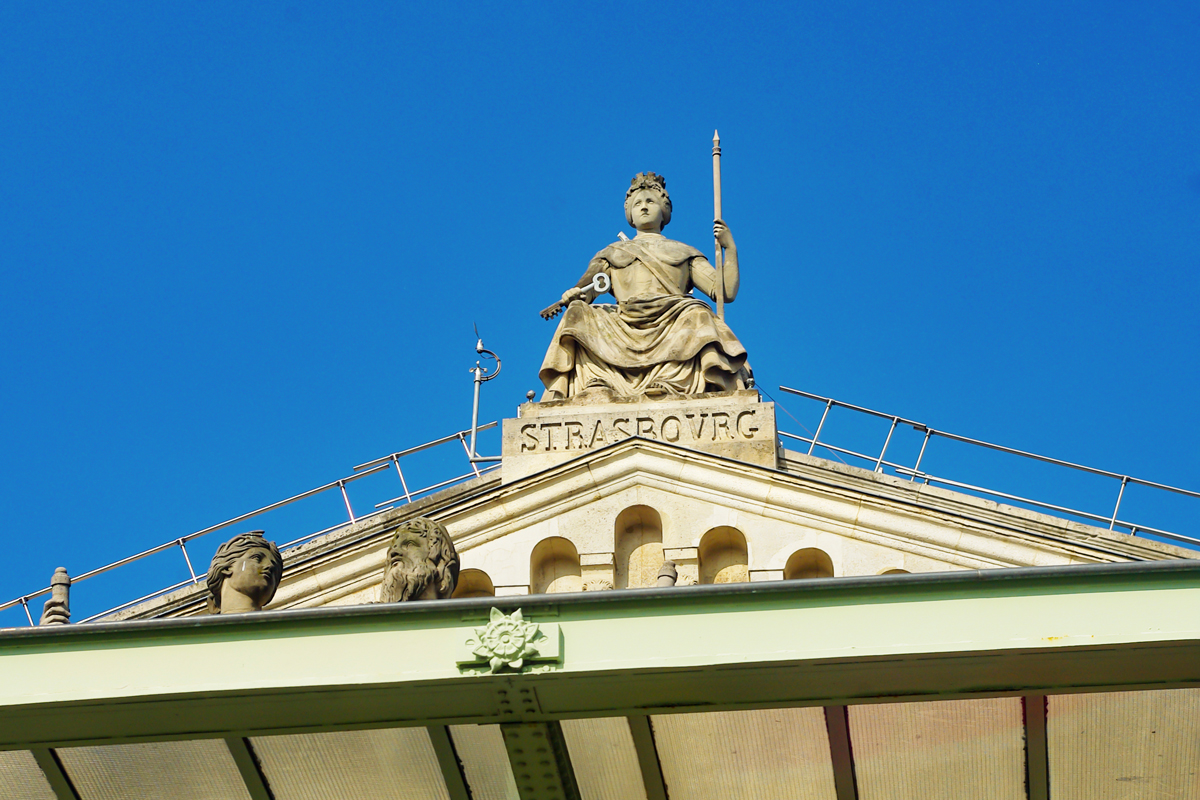
Strasbourg's allegorical statue © French Moments

Verdun's allegorical statue © French Moments
The two wings are connected by a building featuring elegant arcades. These display the coats of arms of the 32 eastern towns served by the railway station.

The station's arcades © French Moments
The two main halls
Inside, there are two large halls lit by beautiful glass roofs:
- the departures hall (hall des départs - hall Alsace, 1850) and
- the arrivals hall (hall des arrivées - hall Saint-Martin, 1931, Art Deco style).

Inside the station: the "Alsace" hall and its 1850 glass roof from 1850 © French Moments
5. Traffic and destination issues
Gare de l'Est is a major rail hub, with no fewer than 41,240,100 visitors passing through in 2019, putting it in fifth place among Paris's six major stations.

The 5th busiest terminus station in Paris © French Moments
It has 15 platforms (quais) and 29 tracks (voies), the same number as its neighbour, Gare du Nord. These platforms are divided into two vast and distinct areas:
The "Banlieue" traffic
Tracks 13 to 22 are reserved exclusively for Transilien line P. This suburban line serves destinations such as Meaux, Château-Thierry, Coulommiers and Provins, providing a vital network for Parisian commuters.
The "Grandes Lignes" traffic
The platforms for national and international services are divided into two clearly defined zones:
- The yellow zone, located opposite the Alsace passenger hall, covers tracks 2 to 12. It mainly provides connections to Alsace and other European destinations.
- The blue zone, created during the 1930 extension and located opposite the Saint-Martin hall, covers tracks 23 to 30. It is the departure and arrival point for trains to Champagne-Ardenne and Lorraine.

ICE and TGV © French Moments
6. Four historic lines and a "LGV"
From Gare de l'Est, four major historic railway lines radiate outwards:
- Reims and Charleville-Mézières
- Metz and Sarrebruck
- Nancy and Strasbourg
- Troyes, Belfort and Mulhouse.
The arrival of the TGV
In 2007, a major event took place at Gare de l'Est with the launch of the brand new TGV-Est-Européen high-speed train. This expansion considerably broadened the station's reach, offering fast connections to a number of key destinations. The LGV Est (Ligne à Grande Vitesse Est or Eastern High-Speed Line), played a central role in this expansion.

TGV Est © French Moments
The LGV Est is one of France's most important high-speed lines. It was built to improve rail connectivity between Paris and eastern France, as well as other European destinations. The line allows high-speed travel (up to 320 km/h or 200 mph) and has significantly reduced journey times to cities such as Reims (45 min), Metz (1h20), Nancy (1h30), Strasbourg (1h50), and even beyond the French borders to Germany.

TGV in gare de Paris-Est © French Moments
The integration of Gare de l'Est into the LGV Est network has helped to strengthen its position as a preferred departure point for passengers travelling to these destinations, offering fast and efficient access to large parts of eastern France and Europe.

TGV in gare de Paris-Est © French Moments
7. A busy métro station
To facilitate access to the station, a metro station called "Gare de l'Est" has been set up, offering a convenient connection with metro lines 4, 5 and 7, reinforcing its connectivity to the French capital's public transport network.

Gare de l'Est metro station (line 4 platform in 2009) © French Moments
In addition to its key role in the rail network, Gare de l'Est also plays a significant role in Paris' underground transport system. In 2019, it welcomed no fewer than 22,443,106 passengers, making it the fifth busiest of all the capital's metro stations.
This popularity reflects its importance as a major focal point for travel in Paris, confirming its status as a vital part of the city's transport network.
A future service to Paris-Charles-de-Gaulle?
Gare de l'Est will play a key role in one of the Paris region's most eagerly awaited rail projects, the CDG Express.
If the project goes ahead, this station will be the starting point for this private high-service rail link, providing a fast and efficient connection between the heart of Paris and Paris-Charles-de-Gaulle International Airport.
This will give passengers easy access to the airport from the Gare de l'Est, further reinforcing its importance as a major transport hub in the French capital.
8. A moving historical fresco
In the Alsace hall of the Gare de l'Est, don't miss looking up to see "Le départ des Poilus, août 1914", a huge 5 x 12 metre canvas that adorns this area.
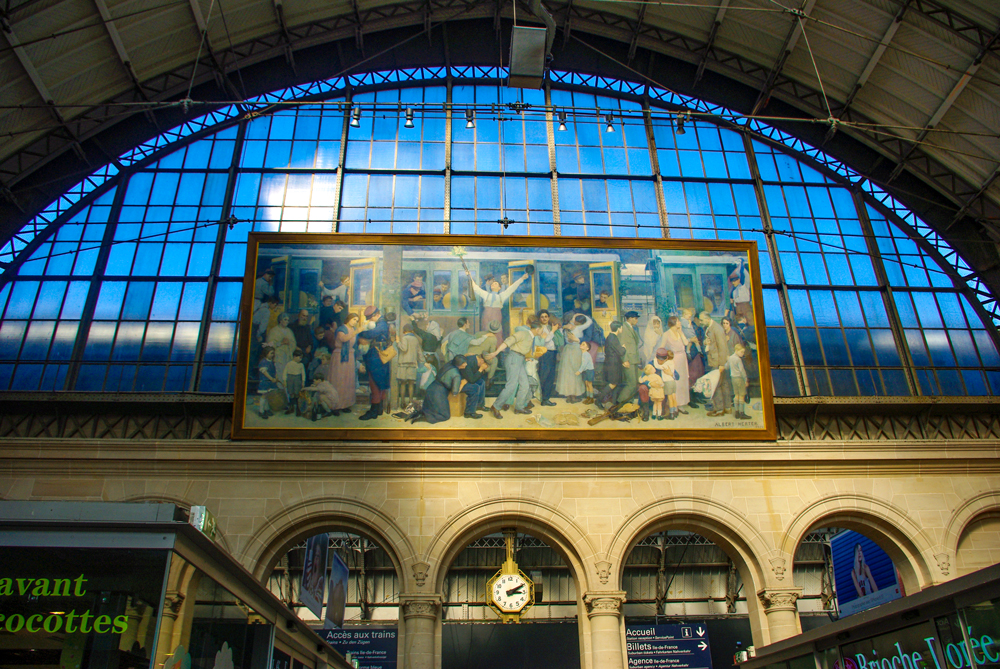
Le Départ des Poilus © French Moments
Unfortunately, very few passengers take the time to look at it carefully. Yet this work of art bears witness to an important historical event that took place in the station between 1914 and 1918: the departure of soldiers for the First World War.
A historical fresco and a personal tribute
This painting was created by the American painter Albert Herter (1871-1950), who donated it to France in 1926. It is both a historical fresco depicting the departure of the soldiers mobilised in August 1914 and a personal tribute to the painter's eldest son, Everit, who voluntarily enlisted in the American troops and lost his life in the Aisne, near Château-Thierry, in 1918.

Le Départ des Poilus © French Moments
The story of a family drama
The painter's son is depicted in the centre of the canvas, his arms outstretched towards the sky and a flower at the end of his rifle, symbolising both his zeal as a volunteer serviceman and perhaps also his tragic fate. Symmetrically to this central figure, his parents are depicted at either end of the painting. On the left, his mother is shown with her hands clasped, while on the right, his father, the painter himself, is leaning his torso slightly forward, one hand over his heart and the other holding a bouquet of flowers, as if he were meditating before the grave of his son buried in France.
To be put into context...
It is important to note that this painting is not an exact representation of the departure of the soldiers in August 1914. At the time, families did not have access to the quay, and the soldiers were not yet in uniform.
![Mobilisation Aout 1914 [Public Domain via Wikimedia Commons] Mobilisation Aout 1914 [Public Domain via Wikimedia Commons]](https://frenchmoments.eu/wp-content/uploads/2023/09/Mobilisation-Aout-1914-Public-Domain-via-Wikimedia-Commons-scaled-1.jpg)
The mobilisation of August 1914 on the forecourt of the Gare de l'Est [Public Domain via Wikimedia Commons].
Nevertheless, it reflects the state of mind of the soldiers and their families at the time of departure. It represents all generations, showing young fathers embracing their wives or children, as well as older figures, probably the fathers and mothers of the mobilised soldiers.
![Train de mobilisés 02 août 1914 [Public Domain via Wikimedia Commons] Train de mobilisés 02 août 1914 [Public Domain via Wikimedia Commons]](https://frenchmoments.eu/wp-content/uploads/2023/09/Train-de-mobilises-02-aout-1914-Public-Domain-via-Wikimedia-Commons-scaled-1.jpg)
Train of conscripts leaving the Gare de l'Est on 2 August 1914 [Public Domain via Wikimedia Commons].
The crypt of the railway workers who died for France
Opposite the platforms, you will discover a moving plaque dedicated to "the railwaymen of the Eastern network who died for France". This plaque has been carefully placed on the wall of the Crypt of Remembrance, commemorating the sacrifices of the railwaymen of the Eastern network who lost their lives for France during the two world wars. It is a place of remembrance and respect for those who showed dedication and courage at difficult times in history.

The crypt of the railway workers who died for France © French Moments
9. Films shot at Gare de l'Est
Gare de l'Est is a particularly attractive location for film shoots set in a railway station. It has level access and far less traffic than its Parisian counterparts. As a result, it is not uncommon for it to be transformed into the Gare du Nord, or even the Gare Saint-Lazare, Gare de Lyon or Gare d'Austerlitz for film productions.
Here is a small sample of famous films shot at the Gare de l'Est:
- Berlin Express by Jacques Tourneur (1948), starring Merle Oberon and Robert Ryan.
- Quai de Grenelle by Émile-Edwin Reinert (1950), starring Henri Vidal and Maria Mauban.
- Le Château de verre by René Clément (1950), starring Jean Marais and Michèle Morgan.
- Zazie dans le métro by Louis Malle (1960), starring Catherine Demongeot and Philippe Noiret.
- L'Homme de Rio by Philippe de Broca (1964), with Jean-Paul Belmondo and Françoise Dorléac.
- La Grande Vadrouille by Gérard Oury (1966), famous for the presence of Louis de Funès and Bourvil.
- Les Ripoux by Claude Zidi (1984), starring Thierry Lhermitte and Philippe Noiret.
- Amélie by Jean-Pierre Jeunet (2001), starring Audrey Tautou and Mathieu Kassovitz.
These films have helped to make the Gare de l'Est an iconic location for French cinema, giving it a special place in the history of the seventh art.
10. An Alsatian Christmas Market
During the first two weeks of December, the Place du 11 novembre 1918 becomes the venue for the Alsatian Christmas market at the Gare de l'Est, an exceptional event.

Le marché de Noël alsacien de la gare de l'Est © French Moments
This Christmas market, the oldest organised outside the Alsace region, celebrates its 41st edition in 2023. Its history dates back to its creation by the director of the Gare de l'Est and the Maison de l'Alsace. Among the many visitors it attracts, it is particularly popular with Alsatians living in Paris, offering them a bit of the warmth of their native region right in the heart of the French capital.

Marché de Noël alsacien à Paris © French Moments
On the forecourt of the Gare de l'Est, a vast marquee houses the stalls of around fifteen producers and craftspeople from Alsace. You'll find a variety of the local produce for which this beautiful region is famous, offering visitors an authentic experience of Alsace, its cuisine and crafts in a warm and festive Christmas atmosphere.

Bredelas at the Alsatian Christmas market © French Moments
11. A Royal BONUS !
In August 1855, Queen Victoria and Prince Albert spent ten days in Paris at the invitation of Napoleon III and his wife Eugénie. This historic State visit was intended to celebrate the military alliance between Great Britain and France during the Crimean War.

Victoria and Albert's family in 1846 by Franz Xaver Winterhalter
At the end of the visit, the royal couple returned by train from Strasbourg station (the Gare de l'Est) to Boulogne-sur-Mer, from where they left by boat for Osborne on the Isle of Wight.
Interestingly, the British monarchs have not left Paris from the Gare du Nord!
Find out more about Gare de l'Est
- Do you love stations? Please read my full article (in French) on the magnificent Metz Railway Station, a historic building in the German imperial district.
- Discover the Alsatian Christmas Market of Gare de l'Est.
- Find out more about the Paris-Est Station in Wikipedia.
- Download the PDF map of the railway station.

Gare de Paris-Est © French Moments
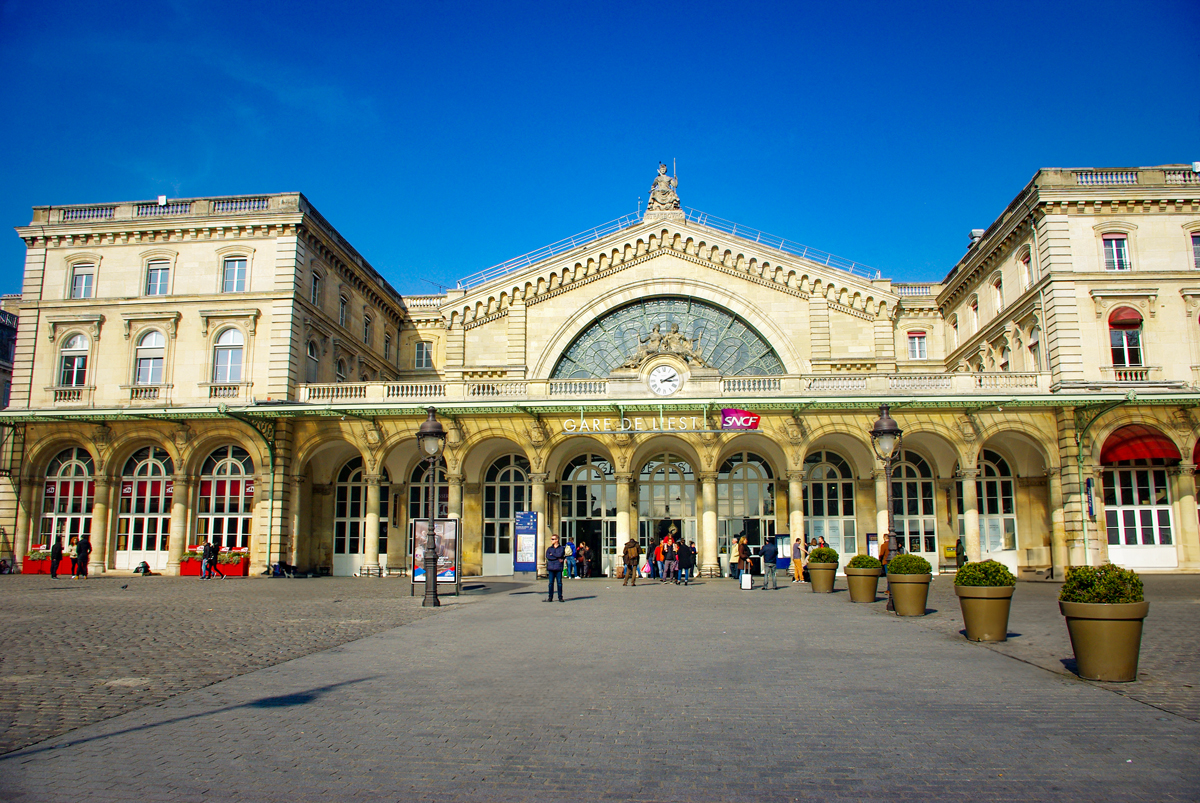
The station's parvis © French Moments

The entrance to the station (hall Alsace) © French Moments
Find a hotel near Gare de l'Est
Leaving the Gare de l'Est station, you can't fail to notice the large number of hotels in the area. The quality of these establishments has improved considerably over the years. The small, basic and sometimes insalubrious hotels have mostly disappeared, giving way to a general move upmarket in the hotel offer.
As a result, several quality independent hotels have sprung up in this part of Paris's 10th arrondissement. Many boutique hotels, ranging from 3 to 4 stars, offer a unique experience. For those who like the modern, standardised feel of hotel chains such as Ibis or Kyriad, these big names are also well-represented near the Gare de l'Est, offering quality accommodation from 2 to 3 stars. Your choice will depend mainly on the location that suits you best.
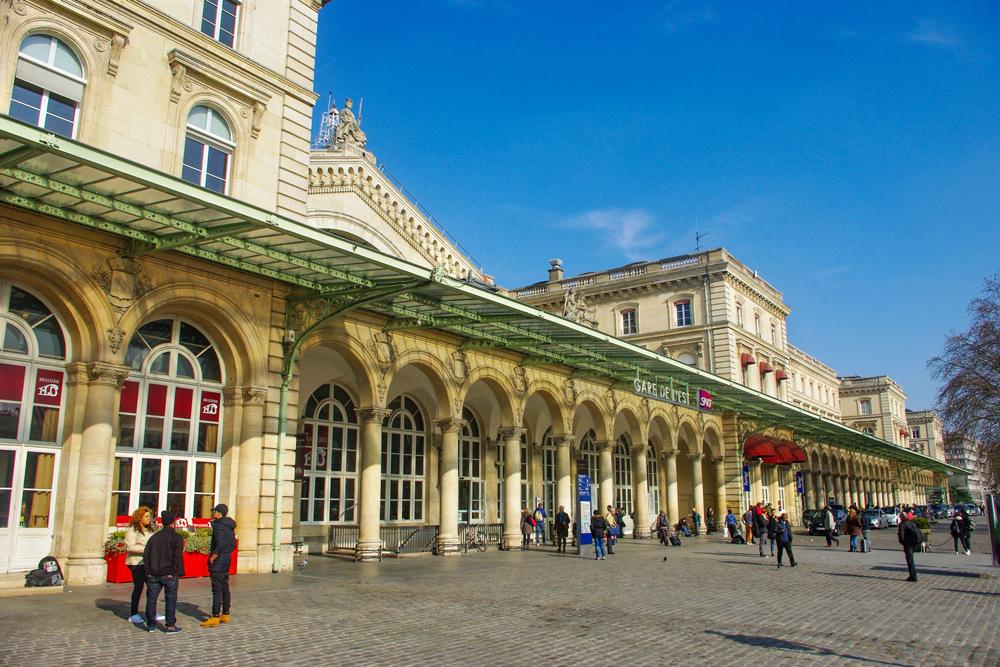
Paris-Est station © French Moments
To cater for everyone's needs, below is a non-exhaustive list of quality hotels near Gare de l'Est, to suit different budgets and preferences.
Share the article!
Did you like this article? Pin the image below on Pinterest or share the article on Facebook and X (Twitter).



![Reseau Paris Est © Sémhur - licence [CC BY-SA 4.0] from Wikimedia Commons Reseau Paris Est © Sémhur - licence [CC BY-SA 4.0] from Wikimedia Commons](https://frenchmoments.eu/wp-content/uploads/2023/09/Reseau-Paris-Est-©-Semhur-licence-CC-BY-SA-4.0-from-Wikimedia-Commons-scaled-1.jpg)



Pierre, what an interesting peek into this beautiful station. The next time I take a train to the east I'll be sure to get there early to appreciate its history and beauty. Merci!
You’re welcome! It’s is one of my favourite Paris stations with Gare de Lyon! 🙂